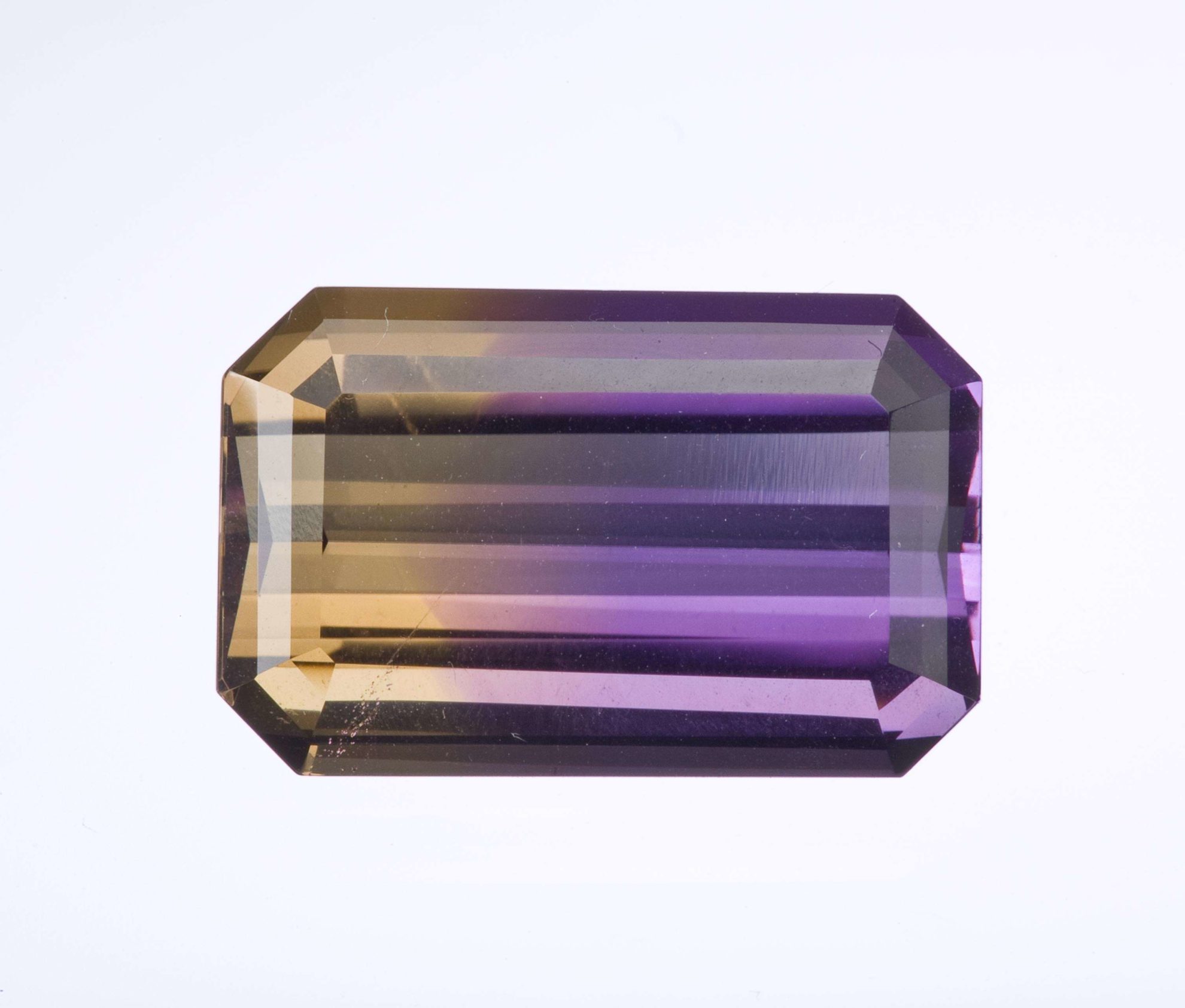Ametrine Value, Price, and Jewelry Information
Ametrine is a variety of quartz that displays bands of both amethyst purple and citrine yellow. These gems are typically cut to showcase their dramatic color zoning.
2 Minute Read
Amethyst is a purple quartz. Citrine is a yellow quartz. Quartz that displays bands of both purple and yellow is known as ametrine. Gem-quality ametrine is sourced from only a single site in Bolivia. Emerald cuts and fantasy carvings are popular ways to showcase the dramatic color zoning in this very durable gemstone.
Start an IGS Membership today
for full access to our price guide (updated monthly).Ametrine Value
Like most quartz gems, ametrine occurs in fairly large, clean pieces. Thus, the price per carat doesn’t increase with larger size stones. Ametrine prices are rather modest. As far as the material itself, the depth and vividness of colors and the distinction of the color separation are the main value points.
The artistry of the cutting or carving adds most of the value to many ametrine pieces. You’ll find a world of difference between a commercial grade or native cut and a fine custom stone, even when cut from the same rough material.
Are Ametrines Natural Gemstones?
Although ametrine's color zoning may lead some to question whether it's a naturally occurring gem, there's a geological explanation for it. This gemstone's abrupt color transition reflects slight fluctuations in temperature and pressure during its formation. Depending on these factors, iron impurities could lead to the formation of amethyst (purple) or citrine (yellow) zones within a single quartz stone.
Today, laboratories can actually artificially heat amethysts to create a great deal of citrine. So, you can easily imagine how natural heating and/or cooling can produce the bi-colored ametrines. Of course, some ametrines can be artificially colored or created. See the section on synthetics below for more information.
Does Ametrine Make a Good Jewelry Stone?
Quartz gems like ametrines make excellent jewelry stones, due to their relatively high hardness of 7 and lack of cleavage.
Ametrine Gem Designs
Faceters, cabbers, and carvers all favor ametrine because of its clarity and good size. When this material entered the market in significant quantities in the 1970s, gem cutters preferred emerald-cut shapes with a 50/50 color split. Many still cut rough in this manner.
Recently, some cutters have begun to experiment with a variety of shapes. Many of these designs create internal reflections that blend the yellow and purple into attractive shades of rosy gold, mauve, and champagne.
Other designs produce mosaic-like flashes of both yellow and purple.
Are There Synthetic Ametrines?
Both heat enhanced natural quartz and synthetic ametrine are available on the market. Optically and physically, these materials match their natural counterparts, so gemological testing is necessary to distinguish them. Detecting twinning in natural quartz stones like ametrines used to be a sign of natural origin. However, synthetic quartz can now duplicate twinning.
Where is Ametrine Found?
Although ametrine was first reported from Rio Grande do Sul, Brazil, the Anahí Mine in Bolivia currently produces all the known, gem-quality material. The native peoples of the region have long valued this stone. However, the mine was seemingly lost to commercial interests after the 17th century and not rediscovered until the 1960s.
Non-commercial deposits have also been found in the United States, Canada, India, and Mozambique.
Ametrine Trade Names
Vendors sometimes refer to ametrines as "amethyst-citrine" or "citrine-amethyst." Other names include "trystine" and "golden amethyst."
You might also encounter the trade name "Bolivianite," especially in Bolivia. However, the use of this term isn't recommended, because the name has been previously applied to other minerals.
How to Care for Ametrines
Ametrines require no special care, since they're not sensitive to temperature changes or household chemicals. You can clean ametrines safely with mechanical systems.
Consult our gemstone jewelry cleaning guide for more information.
Joel E. Arem, Ph.D., FGA
Dr. Joel E. Arem has more than 60 years of experience in the world of gems and minerals. After obtaining his Ph.D. in Mineralogy from Harvard University, he has published numerous books that are still among the most widely used references and guidebooks on crystals, gems and minerals in the world.
Co-founder and President of numerous organizations, Dr. Arem has enjoyed a lifelong career in mineralogy and gemology. He has been a Smithsonian scientist and Curator, a consultant to many well-known companies and institutions, and a prolific author and speaker. Although his main activities have been as a gem cutter and dealer, his focus has always been education. joelarem.com
Barbara Smigel, PhD. GG
Barbara Smigel is a GIA Graduate Gemologist, faceter, jewelry designer, gem dealer, gemology instructor and creator of the well-regarded educational websites acstones.com and bwsmigel.info.
Related Articles
Crystalline Quartz Buying Guide
Black Diamond Value, Price, and Jewelry Information
Chameleon Diamond Value, Price, and Jewelry Information
Gray Diamond Value, Price, and Jewelry Information
Latest Articles
800 Years of Mogok: A Celebration in Tenuous Times
What is the Average Gemstone Faceting Yield?
Pyroxmangite Value, Price, and Jewelry Information
How to Identify Emerald Simulants and Synthetics
Never Stop Learning
When you join the IGS community, you get trusted diamond & gemstone information when you need it.
Get Gemology Insights
Get started with the International Gem Society’s free guide to gemstone identification. Join our weekly newsletter & get a free copy of the Gem ID Checklist!
